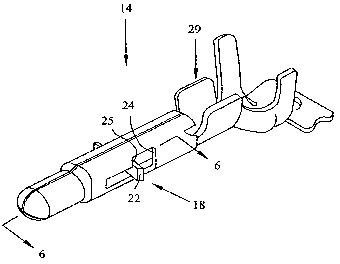Some of the information on this Web page has been provided by external sources. The Government of Canada is not responsible for the accuracy, reliability or currency of the information supplied by external sources. Users wishing to rely upon this information should consult directly with the source of the information. Content provided by external sources is not subject to official languages, privacy and accessibility requirements.
Any discrepancies in the text and image of the Claims and Abstract are due to differing posting times. Text of the Claims and Abstract are posted:
| (12) Patent Application: | (11) CA 2636019 |
|---|---|
| (54) English Title: | CONTACT WITH IMPROVED RETENTION MEMBER |
| (54) French Title: | CONTACT AVEC ELEMENT DE RETENTION AMELIORE |
| Status: | Deemed Abandoned and Beyond the Period of Reinstatement - Pending Response to Notice of Disregarded Communication |
| (51) International Patent Classification (IPC): |
|
|---|---|
| (72) Inventors : |
|
| (73) Owners : |
|
| (71) Applicants : |
|
| (74) Agent: | SMART & BIGGAR LP |
| (74) Associate agent: | |
| (45) Issued: | |
| (86) PCT Filing Date: | 2007-01-31 |
| (87) Open to Public Inspection: | 2007-08-09 |
| Examination requested: | 2008-07-10 |
| Availability of licence: | N/A |
| Dedicated to the Public: | N/A |
| (25) Language of filing: | English |
| Patent Cooperation Treaty (PCT): | Yes |
|---|---|
| (86) PCT Filing Number: | PCT/US2007/002715 |
| (87) International Publication Number: | US2007002715 |
| (85) National Entry: | 2008-07-10 |
| (30) Application Priority Data: | ||||||
|---|---|---|---|---|---|---|
|
An electrical terminal (2) includes a body (4) having a locking member (6) and
the locking member extends through an aperture (10) and backs up to the body.
The locking member is configured to abut the housing, in one embodiment the
locking member is disposed through the channel defined by the body while
another embodiment a plurality of locking members are at least partially
disposed within the channel . Preferably, the locking member is stamped out
from the body. In a variation the body has a projection which can abut the
housing to lock the body into the housing.
La présente invention concerne une borne électrique qui comprend un élément de verrouillage, qui se prolonge à travers une ouverture et soutient le corps. L'élément de verrouillage est configuré pour buter contre le logement. Dans un mode de réalisation, l'élément de verrouillage est disposé à travers le canal défini par le corps tandis que dans un autre mode de réalisation, une pluralité d'éléments de verrouillage est au moins partiellement disposée dans le canal. De préférence, l'élément de verrouillage est détaché du corps. Dans une variation, le corps possède une projection qui peut buter sur le logement pour verrouiller le corps dans le logement.
Note: Claims are shown in the official language in which they were submitted.
Note: Descriptions are shown in the official language in which they were submitted.

2024-08-01:As part of the Next Generation Patents (NGP) transition, the Canadian Patents Database (CPD) now contains a more detailed Event History, which replicates the Event Log of our new back-office solution.
Please note that "Inactive:" events refers to events no longer in use in our new back-office solution.
For a clearer understanding of the status of the application/patent presented on this page, the site Disclaimer , as well as the definitions for Patent , Event History , Maintenance Fee and Payment History should be consulted.
| Description | Date |
|---|---|
| Application Not Reinstated by Deadline | 2011-01-31 |
| Time Limit for Reversal Expired | 2011-01-31 |
| Inactive: Abandoned - No reply to s.30(2) Rules requisition | 2010-07-05 |
| Deemed Abandoned - Failure to Respond to Maintenance Fee Notice | 2010-02-01 |
| Inactive: S.30(2) Rules - Examiner requisition | 2010-01-04 |
| Inactive: Office letter | 2009-03-25 |
| Letter Sent | 2009-03-16 |
| Letter Sent | 2009-03-16 |
| Inactive: Office letter | 2009-03-16 |
| Letter Sent | 2009-03-16 |
| Inactive: Single transfer | 2009-01-21 |
| Correct Applicant Request Received | 2008-11-07 |
| Inactive: Cover page published | 2008-11-03 |
| Letter Sent | 2008-10-20 |
| Inactive: Acknowledgment of national entry - RFE | 2008-10-20 |
| Inactive: First IPC assigned | 2008-08-21 |
| Application Received - PCT | 2008-08-20 |
| National Entry Requirements Determined Compliant | 2008-07-10 |
| Request for Examination Requirements Determined Compliant | 2008-07-10 |
| All Requirements for Examination Determined Compliant | 2008-07-10 |
| Application Published (Open to Public Inspection) | 2007-08-09 |
| Abandonment Date | Reason | Reinstatement Date |
|---|---|---|
| 2010-02-01 |
The last payment was received on 2009-01-02
Note : If the full payment has not been received on or before the date indicated, a further fee may be required which may be one of the following
Patent fees are adjusted on the 1st of January every year. The amounts above are the current amounts if received by December 31 of the current year.
Please refer to the CIPO
Patent Fees
web page to see all current fee amounts.
| Fee Type | Anniversary Year | Due Date | Paid Date |
|---|---|---|---|
| Request for examination - standard | 2008-07-10 | ||
| Basic national fee - standard | 2008-07-10 | ||
| MF (application, 2nd anniv.) - standard | 02 | 2009-02-02 | 2009-01-02 |
| Registration of a document | 2009-01-21 |
Note: Records showing the ownership history in alphabetical order.
| Current Owners on Record |
|---|
| TYCO ELECTRONICS CORPORATION |
| Past Owners on Record |
|---|
| DAVID JAMES FABIAN |
| DONALD ALAN DIEMER |
| DONALD MICHAEL BAUGHN |